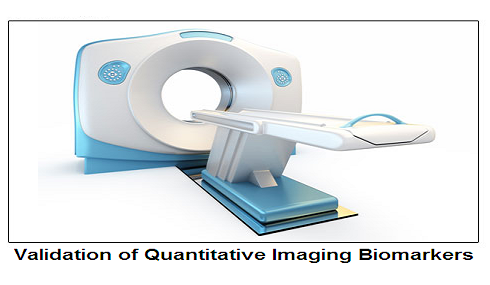Validation of Quantitative Imaging Biomarkers
The FDA makes a distinction between white-listing (approval or clearance) of a diagnostic drug or device for commercial purposes and qualification of a measurement itself to be used as a biomarker in clinical trials. Approval is only available after demonstrating the safety and effectiveness of a device or drug. However, the criteria for effectiveness vary between different devices, which are approved by the CDRH (the FDA Center for Devices and Radiological Health), while the criteria for effectiveness vary between different drugs, which are approved by the CDER (the FDA Center for Drug Evaluation and Research). The pathways to achieve approval and qualification within the FDA are different because their relative risks are usually different. Moreover, the criteria for effectiveness will depend on the labeling claim that the Brand or sponsor is proposing. [1]
Qualification is a measure of the use of a biomarker in a specific context [2]:
That context may be by sorting people for a clinical trial (selecting or deselecting people for a clinical trial), or by monitoring drug induced toxicity, etc… The amount of evidence needed to qualify a biomarker for a given purpose relies on the outcome of using it, and the aid it can provide when it comes to make decisions, such assessment can be utilized to pursue the development of a device/drug or whether to withhold a device/drug from individual utilization in a clinical trial. Qualification mandates context-specific measurement of the biomarker performance relative to an outcome-of-interest. The FDA uses the term validation to refer to the technical or analytic performance of a test or device.
The validation of a quantitative imaging biomarker demands the availability of two criteria:
- The presence of a quantitative imaging biomarker that is closely coupled and/or properly linked to the presence of the target condition or disease (by demonstrating an association between the measured biomarker value and a physiologic, pathophysiological or therapeutic response manifested by physiologic, anatomic, biochemical or cellular changes). Statistical models or classifiers can be used to analyze the Associations between these changes and disease state.
- The detection and quantitative measurement of the quantitative imaging biomarker are reproducible accurate and feasible overtime.
It is possible for devices capable of demonstrating a quantitative imaging biomarker to be approved, but the quantitative imaging biomarker demonstrated by them not to be qualified, or conversely for a quantitative imaging biomarker to be qualified but not supported by products approved for market.
The most stringent validation is mandatory when a quantitative imaging biomarker is being evaluated for utilization as a surrogate endpoint. According to Weir and Walley for the validation of a biomarker as a surrogate endpoint the therapeutic outcome on the biomarker must match with the therapeutic outcome on the final endpoint, so that an authentic surrogate endpoint can be used to allocate the proper therapy regarding the impact of an intervention on an elective true clinical endpoint, which is a key in the validation of a quantitative imaging biomarker for usage as a surrogate endpoint. In the validation process of a biomarker as a surrogate endpoint demonstrating the correspondence with the clinical endpoint is not enough, which remains an obstacle in validating a biomarker as a surrogate endpoint.[3]
References
- emc.healthyorthodoxmedicine
- Olson S, Robinson S, Giffin R. Accelerating the development of biomarkers for drug safety: workshop summary Washington, DC: National Academies Press, 2009
- pubs.rsna.org/doi/full/10.1148/radiol.10100800
Verified by: Dr.Diab (January 7, 2017)
Citation: Dr.Diab. (January 7, 2017). Validation of Quantitative Imaging Biomarkers. Medcoi Journal of Medicine, 1(2). urn:medcoi:article17231.














There are no comments yet
Or use one of these social networks